Rock Xtreme! XTR-3.4EE – Gaming Notebook Review
Rock Xtreme! XTR-3.4EE – Gaming Notebook
In an effort to create the ultimate mobile gaming system, Rock has built the fastest notebook we've ever seen.
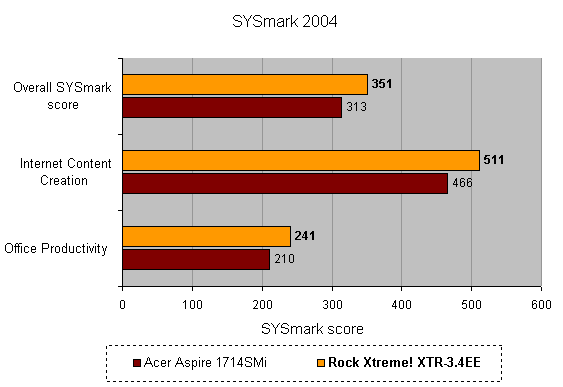
Verdict
Key Specifications
- Review Price: £2349.00
A fair few fast notebooks have landed on my desk over the past months, but this monster machine from Rock is the fastest mobile computer I’ve ever seen. The Xtreme! XTR-3.4EE is aimed at the mobile gamer that doesn’t want to compromise on quality or performance, and Rock has fulfilled this brief very well.
So, what is it that makes this notebook so blisteringly fast? The clue is in the name – XTR-3.4EE relates to the CPU which is of course a 3.4GHz Pentium 4 Extreme Edition. This is currently the fastest CPU you can get, although it carries with it a terrifying price tag, but if you want ultimate performance you’ll have to pay the ultimate price. Of course with the Pentium 4 Extreme Edition it’s not just the clock speed that makes it fast, it’s the huge amount of cache on board. On top of the standard 512KB of Level 2 cache, the Extreme Edition sports another 2MB of Level 3 cache, making it super-fast and super-expensive.
But it’s not just the CPU that makes this notebook fast. You also get 1GB of 400MHz DDR memory to keep things ticking over as smoothly as possible, while the 60GB 7200rpm hard disk is both fast and capacious. But making this a true mobile games station is an ATI Mobility Radeon 9700 graphics chipset, complete with 128MB of memory. This is currently the fastest mobile graphics chipset around and complements the rest of the spec well.
So that’s the performance spec out of the way, but what it the notebook like as a whole? Well, in a single word I’d have to say big. Yes, this is a large and heavy machine – 329 x 290 x 44 (WxDxH) and weighing in at a quoted 3.7kg – I say quoted because I actually weighed this machine myself and it tipped the scales at 4.1kg. But to be fair, I wouldn’t expect a notebook of this spec to be anything but large and heavy. First and foremost, you’d never fit a Pentium 4 Extreme Edition chip in a slimline chassis since there just wouldn’t be enough cooling for the processor to operate properly. Then you have to remember what this machine is all about – gaming, and when you’re playing games you want a decent size screen and keyboard.
Talking of screen and keyboard, Rock has done a pretty good job with both, but it’s the screen that really shines. For a while now Sony has been using special screens in some of its notebooks – originally called Onyx Black and most recently referred to as X-Black. Sony was traditionally the only notebook manufacturer to use this screen technology, but now Rock has also adopted it, calling it X-Glass technology. But whatever this screen technology is called it’s great – the image is so bright and the colours are incredibly vivid. On the down side it is slightly more reflective, but this is a very small price to pay considering how good the image looks in the right lighting conditions. That said, the reflectivity is only an issue if you have a light source directly behind you, and that would affect pretty much any screen. The screen is a 15in example and sports a resolution of 1,400 x 1,050 – this is a pretty standard resolution these days and is easy to work at on a screen this size. Put simply, the display on the Xtreme! is superb, but I would have liked to have seen a widescreen aspect ratio.
The keyboard is often a weak point with a notebook, and anyone who has had the misfortune of having to use a poor notebook keyboard will never want to suffer the experience again. Thankfully, the keyboard on this Rock is a pretty good example and I found it easy to type on for extended periods. It’s not on par with the keyboards you’re likely to find on an IBM ThinkPad, but there is a decent amount of travel in the keys and the break is firm. The Return and Backspace keys are both large making it easy to hit them while typing fast, and the cursor keys are in the correct configuration and are offset from the main keyboard. The only complaint is that there is a degree of flex in the keyboard as a whole, which is a little annoying when typing at speed.
For pointer manipulation Rock has gone for a touchpad. I personally prefer TrackPoints to touchpads, but as far as touchpads go this is a good one. Pointer movement is smooth and accurate when using the touchpad and the two selector buttons have a solid click to them but they’re not too stiff. There’s also a central rocker button for scrolling through pages.
Rock has done its best to make the notebook chassis look as stylish as possible, although it’s not an easy task with something this size. The casing is finished in a shiny lacquered blue and matt silver. The overall effect is OK, but not as good as the Voodoo Envy M:855. Strangely, Rock has mounted the badge on the lid facing the user, this means that when the lid is open the Rock logo is upside down.
On the right of the case you’ll find a Sony four-speed DVD writer that supports both DVD+R/RW and DVD-R/RW media. Next to the optical drive is one of the last examples of a dying breed – a floppy drive, while above the DVD writer is an IrDA port. The left is pretty sparse, sporting only a Type II PC Card slot and the power socket.
At the rear you’ll find a plethora of connections that would put some desktop machines to shame. So, starting at one end and moving across you have a PS/2 port, a parallel port, a D-SUB port, an S-Video connection, four USB 2.0 ports, a gigabit Ethernet port, a modem socket, a four-pin FireWire port, a line-out/optical output, a headphone socket and finally a microphone socket.
On the front of the case is a set of audio controls so you can play CDs without having to boot into Windows. As well as the controls there’s an LCD display to show the track number. This worked very well although I found it rather odd that you have to push the switch towards the off position to turn the CD player on.
As well as all the connection options around the chassis, the Xtreme also has integrated 802.11g WiFi and Bluetooth. So Rock has got just about every conceivable connection option covered.
One thing conspicuous by it’s absence is a card reader, although Rock can supply a 6-in-1 card reader that slots into the floppy bay at a cost of £45.82 inc VAT.
The Xtreme! ships with Microsoft Windwos XP Home pre-installed as well as a copy of Ability Office to get you working out of the box. Talking of working, this machine flies through the office benchmarks. Running SYSmark 2002, the Xtreme! turned in a score of 351 which is phenomenal, and 38 points higher than the previous fastest notebook- the Acer Aspire 1714SMi. Put simply this machine will chew up office applications and spit them out without even breaking a sweat.
But let’s face it, this notebook is all about games not office applications and in its target arena it definitely doesn’t disappoint. Running 3DMark 2001 SE at 1,024 x 768 the Xtreme! managed a score of 13885, while in 3DMark03 it turned in a result of 3898. In comparison, the Acer scored 12339 and 3058 respectively. But when you get to AquaMark the Rock really pulls away from the Acer with a score of 31.44fps at 1,024 x 768 compared with 21.9fps.
But there’s more to gaming than just benchmark results, it’s all about the overall experience when playing. To this end I spent quite a while playing games on the Xtreme! and I have to say that it excelled. Even firing up a heavy duty title like Far Cry couldn’t phase the Xtreme!. I played through several levels of Far Cry and soon forgot that I was playing on a notebook and not a desktop machine. The Xtreme! has built-in stereo speakers and a subwoofer, so even the aural experience is impressive.
Of course the one area where a notebook like this really suffers is battery life, and like the Acer last week Mobile Mark refused to even run. Rock told me that realistically you’ll get about 45 minutes of battery life from the Xtreme! running office applications, although a second battery can be placed in the floppy drive bay. Since this machine is built for playing games, I looped the 3DMark03 demo and timed how long the battery lasted – just under 30 minutes, so you’ll need two batteries if you want an hour of gameplay on the move. All that said, I honestly don’t think that this is a machine designed to be used on battery power. You’re likely to be taking it with you somewhere and plugging it in – whether that be in a hotel room or round at a friends house for some multi-player action.
But cutting edge components and high-end performance come at a price, and this is definitely a very expensive piece of kit. The Xtreme! XTR-3.4EE will set you back a not insignificant £2,348.83 including VAT, which is likely to put a dent in anyone’s finances. The price does include a three-year collect and return warranty which is always welcome.
Ultimately, Rock has created the fastest notebook computer I have ever seen and on that count it should be congratulated. If you want the ultimate gaming experience wherever you may be, this is definitely the machine for you.
”’Verdict”’
This is the fastest notebook you can buy, bar none. If you’re desperate to play the latest games wherever you go, you’ll be very happy with the Rock Xtreme!. The chassis may not be as impressive as something from Voodoo and the price is very high indeed, but the gaming experience is like nothing I’ve ever encountered on a notebook before.
(table:features)

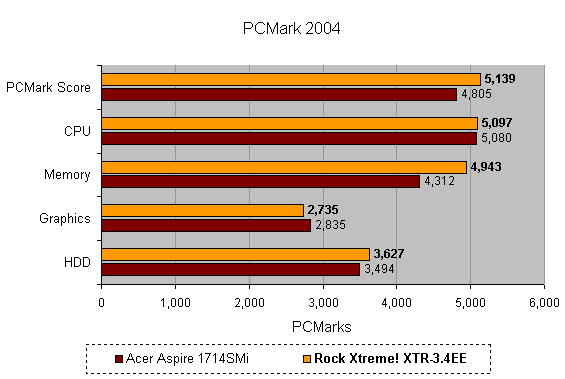
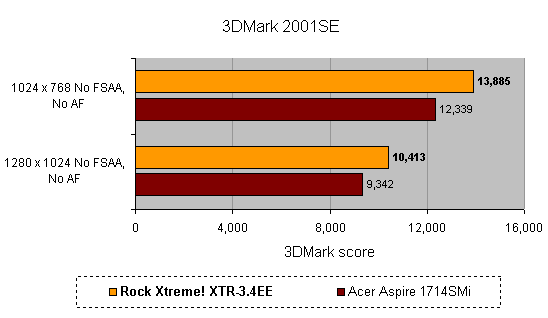
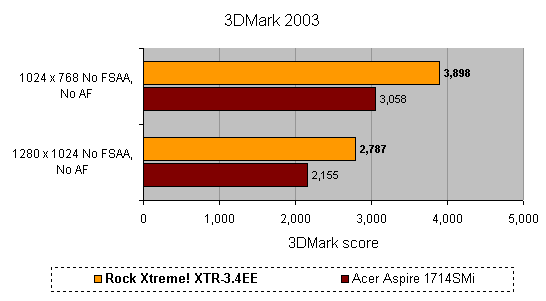
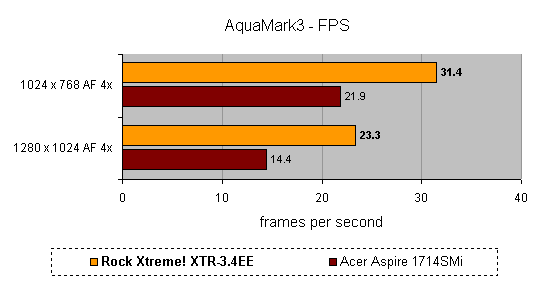
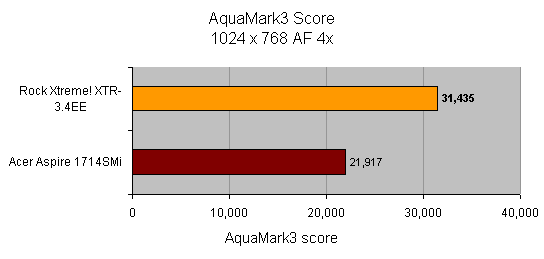
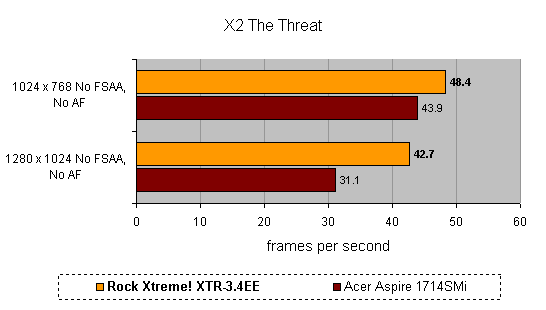
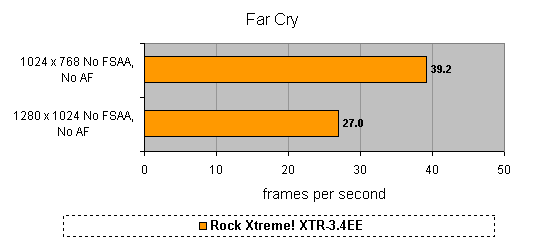
How we test laptops
Unlike other sites, we test every laptop we review thoroughly over an extended period of time. We use industry standard tests to compare features properly. We’ll always tell you what we find. We never, ever, accept money to review a product.
Trusted Score
Score in detail
-
Performance 10
-
Value 6
-
Features 9

